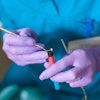
Porcelain laminate veneers are known to provide dependable, conservative treatment for aesthetically problematic anterior teeth. However, issues such as porcelain fracture and chipping can mar results and survival, and long-term clinical data are limited. To learn more, researchers investigated long-term results with this restorative option.
They assessed the clinical performance and longevity of 114 porcelain laminate veneers placed in 26 individuals at one clinic seven to 14 years earlier. Porcelain fracture (4.35%) was the primary reason for failure, and porcelain chipping occurred in 5.26% of veneers, but the survival rate remained high at 98%.
"Porcelain laminate veneer restorations offer a reliable and effective conservative treatment option for enhancing the aesthetics of anterior teeth," wrote the authors, led by Rabia Arif, DDS, an assistant professor of restorative and prosthetic dentistry at the Ohio State University College of Dentistry in Columbus (Journal of Prosthetic Dentistry, March 15, 2019).
Restoration evaluation
“Porcelain laminate veneer restorations offer a reliable and effective conservative treatment option for enhancing the aesthetics of anterior teeth.”
Complete crowns have provided a reliable option for improving unattractive anterior teeth, but they require elimination of tooth structure and may negatively affect periodontal and pulpal tissue, the authors explained. The placement of porcelain laminate veneers, on the other hand, is more conservative and more durable than composite resin veneers, and they provide good aesthetics, according to previous research. Additionally, porcelain laminate veneers bond to enamel instead of dentin, with the former process being more hardy, the authors noted. The researchers, therefore, conducted the current study to assess the clinical performance and longevity of porcelain laminate veneers over the long term.
They mailed recruitment letters to 60 individuals who underwent porcelain laminate veneer placement for aesthetic reasons at one university's graduate restorative clinic at least seven years earlier. The patients were offered free exams and prophylaxis as incentives for taking part in the current study. The 26 patients who agreed to participate underwent clinical evaluation of their veneers using the modified California Dental Association/Ryge criteria.
The researchers evaluated 114 veneers, of which 83 (73%) were maxillary and 31 (27%) mandibular, in the study participants. The majority of the veneers were made of a high-leucite ceramic (Empress, Ivoclar Vivodent). Each was cemented with a standard technique of etch, silane, and cementation with a resin cement.
Of the total veneers, 109 (96%) were clinically acceptable, the researchers found. Five (4%) had failed during service, four due to porcelain fracture, and one underwent conversion to a crown to support a removable partial denture. All failures were in the maxillary arch, with no statistically significant difference between failures in the maxillary and mandibular arches, which may have been due to the small sample size or low failure rate.
| Clinical ratings of 109 porcelain laminate veneers by modified California Dental Association/Ryge criteria | ||||
| Parameter | Alfa n (%) |
Bravo n (%) |
Charlie n (%) |
Delta n (%) |
| Margin integrity | 41 (37%) | 65 (60%) | 3 (3%) | 0 (0%) |
| Porcelain surface | 93 (85%) | 15 (14%) | 1 (1%) | 0 (0%) |
| Anatomic form | 95 (87%) | 14 (13%) | 0 (0%) | 0 (0%) |
| Marginal discoloration | 61 (56%) | 48 (44%) | 0 (0%) | 0 (0%) |
| Secondary caries | 105 (96%) | 4 (4%) | 0 (0%) | 0 (0%) |
The major problems the researchers found were explorer catches at the margins (60%), nonpenetrating margin discoloration (44%), and secondary caries (4%). The most frequent clinical problems were porcelain chipping (6.4%) and the appearance of craze lines (5.5%). Debonding occurred in two veneers (1.8%), which were recemented, and two veneers required endodontic treatment.
Slight marginal defects contributed to the high percentage of restorations rated bravo (24%). They calculated estimated survival probability after seven years at 97.6% and after 14 years at 88.2%, the latter of which was lower due to the smaller sample size.
The two veneers with caries were in the same individual, a mouth breather with caries in other areas. While the carious lesion was repaired with composite resin and the veneers remained intact, the researchers recommended not placing porcelain laminate veneers in patients with active caries and that preparation margins be bound by enamel.
Functional or parafunctional loading may cause fracture, since three of the fractured veneers occurred in the same individual, according to the authors noted. The single case of debonding was possibly related to the operator or material, they noted.
Research drawbacks
The authors listed some limitations of the study, which include this being a retrospective study and not including annual recalls of participants or data on the preparation detail, margin integrity or veneer fit at cementation, patient's hygiene habits, diet, and other information. Additionally, most of the veneers were made from one type of ceramic, and the study's findings, therefore, may not be applicable to newer materials.
Nevertheless, the researchers found that porcelain laminate veneers performed well over the long term.
"The restoration durability after seven to 14 years was satisfactory, with an overall acceptability for all parameters in clinical performance in the high 90%," the authors concluded.



















